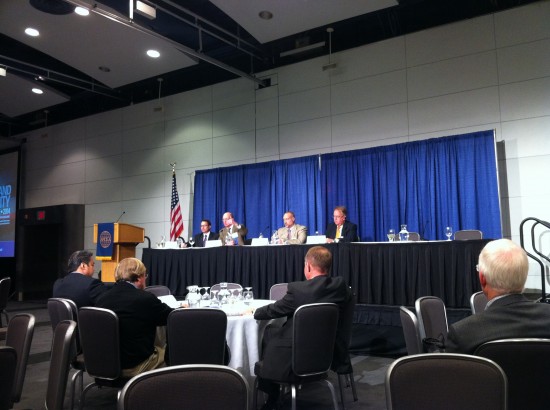 Last week I had the opportunity to attend the AFCEA Homeland Security conference in Washington, D.C.
Last week I had the opportunity to attend the AFCEA Homeland Security conference in Washington, D.C.
Eleven days after the September 11, 2001, terrorist attacks, the first Director of the Office of Homeland Security was appointed leading to the combination of 22 different federal departments and agencies into a unified, integrated cabinet agency when it was established in 2002.
The Department has a vital mission to secure the U.S. from many threats with capabilities that range from aviation and border security to emergency response, from cybersecurity to chemical facility inspections.
The three day conference focused on a number of important topics including:
- Mobility and Interoperability
- Information Sharing and Fusion Centers
- Big Data Analytics
- Role of Laboratories and Scientific Research in Homeland Security
- Cybersecurity Education and Continuous Diagnostics and Monitoring
The conference keynote was delivered by Adm. Thad Allen, USCG, (Ret.), executive vice president of Booz Allen Hamilton and former commandant of the U.S. Coast Guard with a perspective of increasing complexity as the major challenge. This increasing complexity requires cooperation, collaboration, and working in new ways to product results across public and private sector with unity of effort.
T he Mobility and Interoperability panel was focused on the critical need for information sharing across different agencies and departments and the need for interoperable systems and mobile capabilities to transform data and information into actionable knowledge.
he Mobility and Interoperability panel was focused on the critical need for information sharing across different agencies and departments and the need for interoperable systems and mobile capabilities to transform data and information into actionable knowledge.
- Mark Borkowski, Customs and Border Protection Office of Technology Innovation and Acquisition stressed the requirement for federated enterprise approach and need for interoperable data sharing and collaboration across both federal, state, and local agencies as well as international partners such as Canada on the northern border. Sharing images and video from traffic cameras and video surveillance cameras provides situational awareness but present interoperability challenges.
- Richard Reed, director of state plans, FirstNet, provide an update on the initiative to develop a high-speed, nationwide network for public safety. The critical requirement is for the public safety network to be available and reliable during an emergency with capabilities to scale in dense urban environments and remote rural environments.
The Information Sharing and Fusion Center panel shared best practices in the vital role in sharing information local, state and federal agencies during recent tragedies, including the Boston Marathon bombing and the Navy Yard shooting.
- Lee Wight, executive director, Washington Regional Threat Analysis Center emphasized the importance of trust and data overload.
- Sandy Peavy, CIO, Federal Law Enforcement Training Center discussed the impact of the flood of digital evidence that is product by the public via mobile device and social media channels during a crisis such as during the Boston Marathon.
The Big Data panel focused on the explosion of unstructured data from non-traditional sources including social media channels and sensor devices that are emerging as part of the Internet of Things (IoT).
The Laboratories and Scientific Research panels and the two Cybersecurity panels brought the previous sessions together with emphasis on the roles scientific research in the labs and the need for cybersecurity training, education, and skills development and the need to focus on real-time continuous diagnostics and monitoring.
- John Streufert, director of Federal Network Resilience, Department of Homeland Security shared statistics fem the U.S. CERT center that there trillions of cyber-related events every three days and billions of potentially defective hardware, software and account changes with about 10,000 successful attacks every three months. But, the Center for Strategic and International Studies report indicates that Continuous Diagnostics and Mitigation programs can stop 85 percent of the attacks by finding, fixing and reporting the cyber problems with 75 percent of attacks used known vulnerabilities that could be patched. And more than 90 percent of successful attacks required only the most basic cyberattack techniques.
- Adrian Gardner, chief information officer, Federal Emergency Management Agency discussed the role of big data in federal emergency management with data management is managed.
- Timothy Burke, Program Manager with DHS Office of National Laboratories discussed the role of the labs to support the homeland security mission.
- Andy Stadnik, Associate Executive Director for laboratory sciences, Consumer Product Safety Commission shared the agencies role to keep the public safe from defective consumer products with statistics from hospital emergency room reports ranging from injuries to toaster oven fires.
James Blasingame, Deputy National Intelligence Manager (NIM) for the Western Hemisphere, Office of the Director of National Intelligence in his keynote framed the challenges securing cyberspace.
The conference concluded with a focus on the need for strong partnerships. Luke McCormack, DHS chief information officer, and Nick Nayak, DHS chief procurement officer, emphasized the need for effective communications and partnership between the private and public sector at address the challenges and achieve the mission.
It was an informative conference and an important mission for 21st Century government. As I reflect on the conference I want to invite the community in public and private sector to contribute to the evolution of technology and the Internet of Everything with innovation solutions to ensure safety and security in our physical and virtual worlds.
Join the Cisco Security Grand Challenge a global initiative to secure the Internet of Things here.


CONNECT WITH US